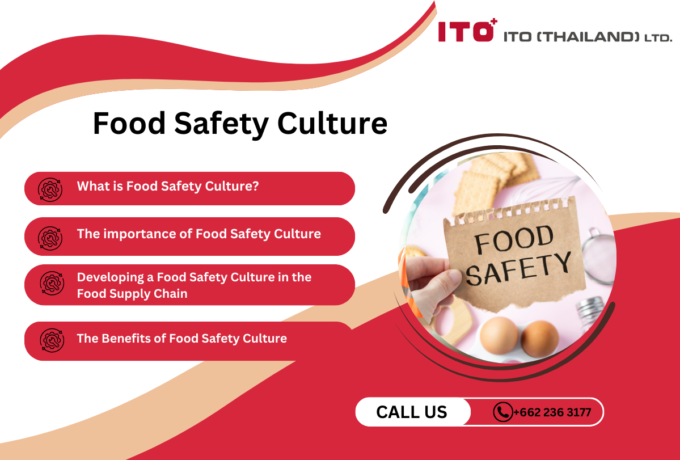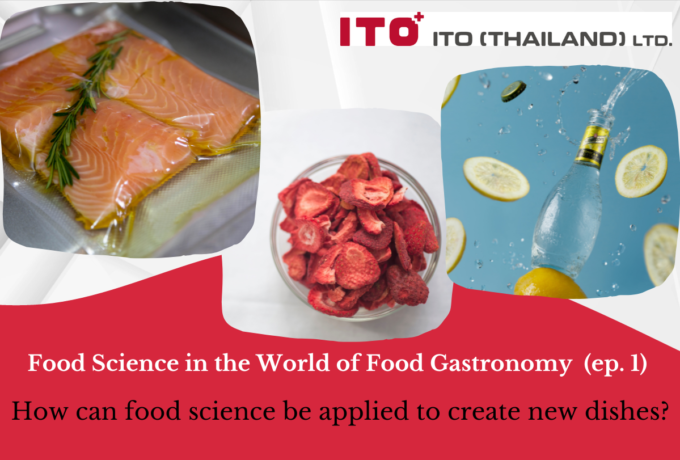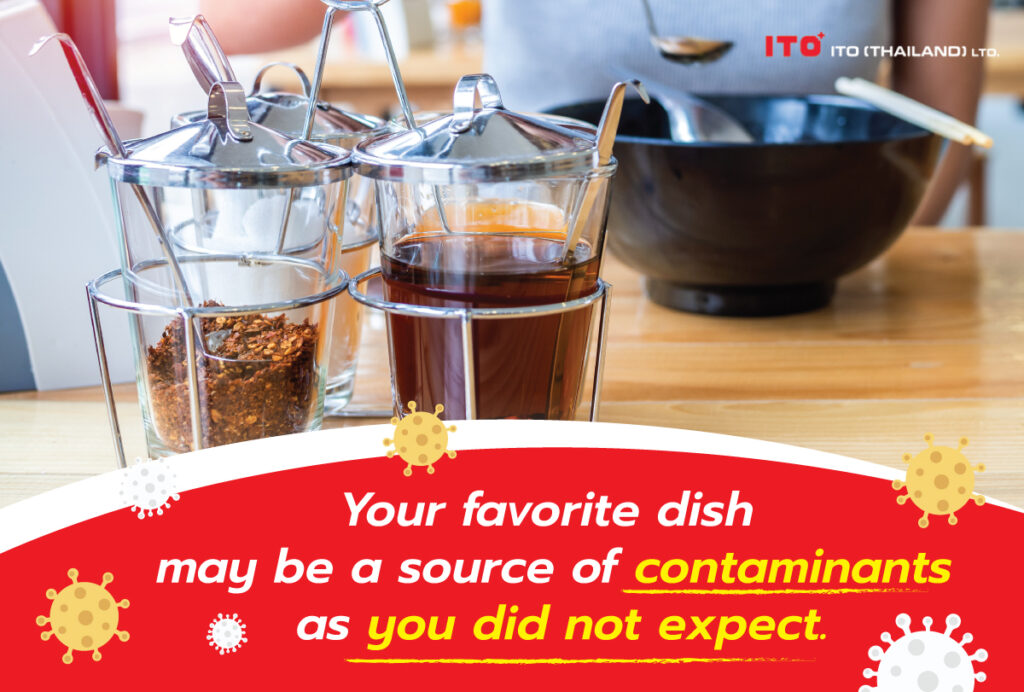ITO Thailand Hygiene Blog
Contamination and food poisoning
Today we are going to unravel whether Teflon pan coatings can actually cause cancer and whether the metal container in the seasoning can actually cause harm, and also advice on how to prevent food poisoning properly because chemicals, contaminants and microorganisms can enter our body easily through the routine that we are not aware of, such as from coatings of pans, pots, tools and utensils, from food poisoning, and from chemical residues in raw materials. Let’s find out what effects these substances have on our bodies and how should we act in order to avoid exposure to these substances.
The most obvious example in our daily life is pan coating. Currently, Teflon pans are very popular because there are many advantages for example:
1.Food does not stick to the pan, which helps reduce oil consumption and is good for health.
2.Reduce scratches from kitchen utensils and equipment.
3.Even heat distribution and easy to use.
4.Easy to take care and clean.
During the manufacturing process, the material is coated by Teflon by using perfluorooctanoic acid (PFOA: Perfluorooctanoic Acid), which is a dangerous chemical because according to results of experiments with animals in the laboratory, it shows that it can increase the risk of liver, testicular, breast and pancreatic cancer (1) .
However, perfluorooctanoic acid tends to get burned completely during the manufacturing process and is not left in sufficient quantities to cause harm to human health, and according to the high heat test with various brands of Teflon pans, no toxicity was found (2) . There is only caution about the smoke resulting from prolonged high heat, which can cause illness that has temporary flu-like symptoms in humans. This kind of smoke does not contain perfluorooctanoic acid since it is already gone during the manufacturing process. Thus, it is not harmful to humans, but it may affect some pets, especially birds such as budgies and parrots, so it is recommended to open a window or hood during cooking every time. We can therefore conclude that Teflon pans that peel after long use has no negative effect on human health. It is just a physical contamination if it gets into the food, which makes it look unappetizing, makes food stick to the pan, and becomes more difficult to use and take care of.
We can see another example in our daily lives when we go to a restaurant to eat. It should be noted what kind of material containers these seasonings such as vinegar, fish sauce are packed in and what kind of material the utensils are made of because these seasonings react with metallic materials (including stainless steel) that can cause a change in color, such as black or brown on the contact surface and have corrosive effect if soaked for a long time causing heavy metals to contaminate food.
Therefore, we should be careful and avoid if we see the use of metal cups or spoons because it may accumulate in the body if consumed for a long time. And we can avoid it by using containers from other materials such as glass or ceramic.
Finally, food poisoning is usually caused by the consumption of food or beverages that are contaminated with pathogenic microorganisms such as Salmonella, Campylobacter or E. coli (3). These pathogens tend to grow well when food is not handled hygienically, such as leaving it at room temperature for more than 4 hours because the food contains complete nutrients and minerals for the growth of pathogenic microorganisms. The most common symptoms are nausea, vomiting, fever, headache, abdominal pain, and diarrhea and can go away on their own by drinking plenty of water and getting enough rest, but in some groups of people, severe symptoms may occur, such as young children, the elderly, and pregnant women.
High-risk food includes unheated foods such as salads, sushi, raw fish, and hand-consumed foods such as sandwiches, hamburgers, and so on. It also has to do with principles of food preparation and unsanitary practices which we can prevent for example:
1.Selection of good raw materials in perfect condition including the packaging that is not torn and has clear expiration date.
2.Hand washing with warm water, soap, wiping them dry and using alcohol to disinfect before preparing food or eating.
3.Not using the same cutting board to cut raw and cooked food as cross-contamination may occur including avoiding using the same pair of chopsticks to pick up raw and cooked food when eating grilled food, BBQ, hot pot, and so on.
4.Cook food properly every time. Avoid eating raw and undercooked food.
ITO THAILAND supports a hygienic, clean and safe food society and wants to be a part of the development, improvement and production of hygienic food for the best interests of consumers by offering services to manage hygiene measures to be in line with the work site of each food factory, and raise awareness about hygiene, hygiene management and consultation with on-site workers including providing comprehensive after-sales service.
Please click here to know more about us.
References
1.Luisa Dillner. Are my non-stick saucepans a health hazard? [Internet]. 2015 [cited 2 Feb 2022]. Available from https://www.theguardian.com/lifeandstyle/2015/jan/25/are-my-non-stick-pans-a-health-hazard-teflon
2.H. Begley,K. White,P. Honigfort,M. L. Twaroski,R. Neches &R. A. Walker [2007]. Perfluorochemicals: Potential sources of and migration from food packaging. Food Additives & Contaminants. Volume 22, 2005 – Issue 10. Available from https://www.tandfonline.com/doi/abs/10.1080/02652030500183474?src=recsys#.VMF7P0ve0ds
3.Better Health Channel. Food poisoning – prevention [Internet]. 2021 [cited 3 Fev 2022]. Available from https://www.betterhealth.vic.gov.au/health/healthyliving/food-poisoning-prevention#people-at-risk-of-food-poisoning
Related Post
-

Food Safety Culture
Food safety culture plays a crucial role in safeguarding the company's reputation, ensuring the well-being of its employees, and providing a safe experience for its customers.
-

New food source safety issues
What are safety issues worth knowing for trendy new food sources like plant-based and insect-based proteins?
-

British Retail Consortium (BRC) Standard
Food safety management systems play a vital role in ensuring the production and distribution of safe and high-quality food products to consumers. With the global food supply chain becoming increasingly complex, food businesses must implement effective systems prioritising safety, quality, and compliance with industry standards. A food safety management system encompasses a set of procedures, processes, and controls designed to identify, prevent, and manage potential hazards at every stage of the food production and supply process. This proactive approach not only safeguards consumers' health but also protects the reputation and credibility of food companies in an ever more competitive market.
-

Food Science in the World of Food Gastronomy (Part 1)
How can food science be applied to create new dishes?
-

FSSC 22000
Food manufacturers must ensure food safety standards and processes. FSSC 22000 is an official certification program for Food Safety Management Systems (FSMS) recognised by the Global Food Safety Initiative (GFSI). This certification scheme offers a set of guidelines and procedures to ensure uniformity, openness, and safety across your entire supply chain. It applies to all companies operating within the food and beverage industry, ranging from farmers to retailers. By fulfilling the necessary criteria and obtaining FSSC 22000 certification, it is demonstrated that the required standards for food quality and implementing effective processes to manage and mitigate risks associated with food fraud, foodborne illnesses, expensive recalls, and other external threats are met.
-

Food Safety Aspects of Artificial Sweeteners
Artificial sweeteners, also known as sugar substitutes, non-nutritive sweeteners, or high-intensity sweeteners, are artificially produced compounds utilised in place of sucrose (table sugar) to add sweetness to food and drinks. Due to their significantly higher sweetness than regular sugar, only a fraction of artificial sweeteners (200 to 20,000 times less) is required to achieve an equivalent level of sweetness. Since the caloric contribution of these sweeteners, when used in such small quantities, is insignificant, they are often referred to as non-nutritive (4).










